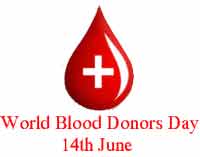World Blood Donor Day is celebrated across the world on 14th June every year.
This is a day to raise awareness of the need for safe blood and blood products and to thank the voluntary unpaid blood donors for their life-saving gifts of blood. There is an urgent need for more people from around the world to become life-savers by volunteering to donate blood on a regular basis. It is said that "More Blood, then More Life".
World Blood Donor Day occurs on June 14, the birthday of Karl Landsteiner, the creator of the ABO Blood Group Systemfor which he won the Nobel Prize. One of the main goals of the World Blood Donor Day is to ensure the availability of 'safe blood' for transfusion.
WHO Member States designated World Blood Donor Day as an annual event to be held each year on 14 June. The launch of World Blood Donor Day took place on 14 June 2004 in Johannesburg, South Africa.
 The aim of World Blood Donor day and linking it to a global celebration is to promote voluntary non-remunerated blood donation throughout the world. By designating one special day to celebrate the role of voluntary blood donors around the world, it is hoped that a new generation of blood donors will follow their example, providing sufficient supplies of the safest blood possible for use wherever and whenever it is needed to save lives.
The aim of World Blood Donor day and linking it to a global celebration is to promote voluntary non-remunerated blood donation throughout the world. By designating one special day to celebrate the role of voluntary blood donors around the world, it is hoped that a new generation of blood donors will follow their example, providing sufficient supplies of the safest blood possible for use wherever and whenever it is needed to save lives.
The blood donation process
- Blood donation is a simple four-step process: registration, medical history and mini-physical, donation and refreshments.
- Every blood donor is given a mini-physical, checking the donor's temperature, blood pressure, pulse and haemoglobin to ensure it is safe for the donor to give blood.
- The actual blood donation typically takes less than 10-12 minutes. The entire process, from the time you arrive to the time you leave, takes about an hour and 15 min.
- The average adult has about 10 units of blood in his body. Roughly 1 unit is given during a donation.
- A healthy donor may donate red blood cells every 56 days, or double red cells every 112 days.
- A healthy donor may donate platelets as few as 7 days apart, but a maximum of 24 times a year. All donated blood is tested for HIV, hepatitis B and C, syphilis and other infectious diseases before it can be transfused to patients.


